The militants of the Polish Socialist Party were not going to stand and passively watch as the Cossacks spread Polish demonstrations and gatherings on their sabers. They wanted to feel the weight of the gleaming revolvers in their hands and shoot the tsarist soldiers without mercy. On November 13, 1904, this dream came true.
At the crack of dawn, the inhabitants of Grzybowski Square in Warsaw and the surrounding streets are torn from their beds by the sound of horse hooves and shod military boots. A good two hundred policemen as well as tsarist horse and pedestrian gendarmes march across the square, divide into smaller units and hide at the gates.
So that they would not slash the defenseless with their sabers anymore ...
Everyone in Warsaw knows about the demonstration against the mobilization of the Polish recruit for the war with Japan convened by the Polish Socialist Party at 1 p.m. in Plac Grzybowski.
Socialists issued three appeals - to workers, to students and to the general public - calling for participation in the protest.
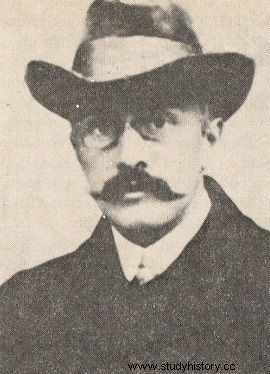
Józef Kwiatek, who headed the conference of Warsaw PPS activists (pictured), could only assume what would happen when the PPS put up an armed resistance to the tsarist soldiers.
As the leaflet of the Warsaw Workers' Committee of the PPS announced yesterday:
Our demonstration should become an impressive expression of the deep hatred of the Polish people towards the entire political system overwhelming us.
Less than two weeks ago, a Peeee demonstration against mobilization marched through the Warsaw district of Leszno. A sotnia of Cossacks and several dozen foot policemen threw their sabers at the defenseless workers. Instead of slapping them, they cut sharply. Nearly 80 wounded were left on the pavement. One of the demonstrators was cut off by a Cossack.
After this tragedy, a conference of one hundred Warsaw PPS activists gathered in an underground flat in Praga. It was headed by Józef Kwiatek. It was unanimously resolved that the PPS would no longer manifest without weapons. Excited socialists, regardless of the threat of exposure, shouted at the top of their throats:
Get the guns! We will pay them back for Leszno!
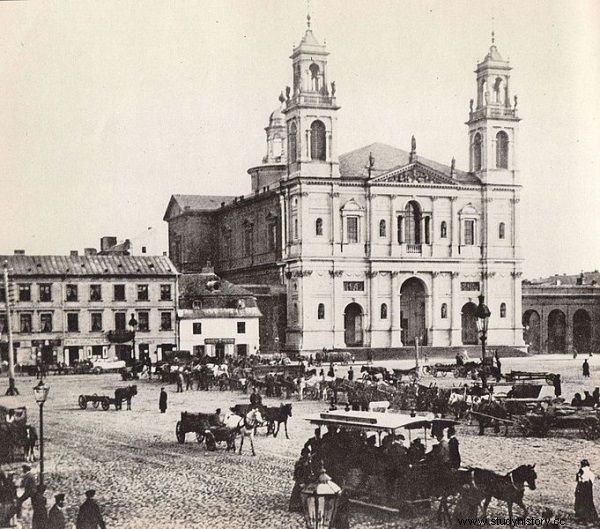
Grzybowski Square in Warsaw became the scene of a bloody clash between Polish patriots and the forces of the invader.
One Walery Sławek and thirty-two Brownings
The envoy of the Warsaw PPS, Walery Sławek, provided with a substantial sum of 600 rubles, tried to buy weapons in Kiev. He failed, but in the end he illegally bought a larger batch of revolvers in Vinnitsa, and another conspirator, Zahorski, bought some more weapons in Poltava.
Two days ago, Sławek, with a transport of 34 revolvers and two browning pistols, by conspirators affectionately called "bronques", reached Warsaw. The weapons were distributed to the so-called old PPS fighters who took part in street demonstrations from the beginning of the year. Students and older students of private technical schools also armed themselves.
Already this spring, at the request of Józef Kwiatek, a student of the Warsaw University of Technology experimented with the production of explosives. By the fall, it had produced 2 kg.
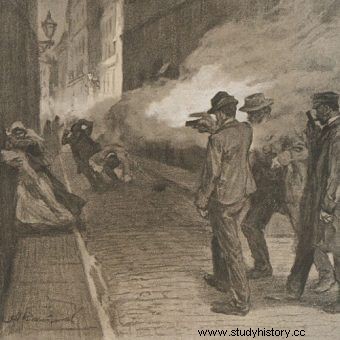
PPS fighters with brownings.
He filled two bombs of his own construction with this measure. Kwiatek, who was organizing the demonstration, decided that both were to be used at Grzybowski Square. Yesterday they were handed over by PPS fighters Józef Ratke and Władysław Gawroński.
The organizers kept the organizers secret of the intention to fight the police during the demonstration. One of the Brownings, however, received the provocateur protected in the PPS, Dawid Ajzenlist, who notified the Oberpolice Major Karl Nolken. As a result of his denunciation, yesterday the security officer arrested one of the Jewish fighters.
"We only go to church"
At eight in the morning, Plac Grzybowski is filled with workers and young people. Tens of thousands of people are in such a crowd that it is difficult to go to church. Police patrols question the people who were there for what they came for. Everyone replies with seriousness that it is for Sunday mass, but the crush today is such that it is impossible to enter the church.
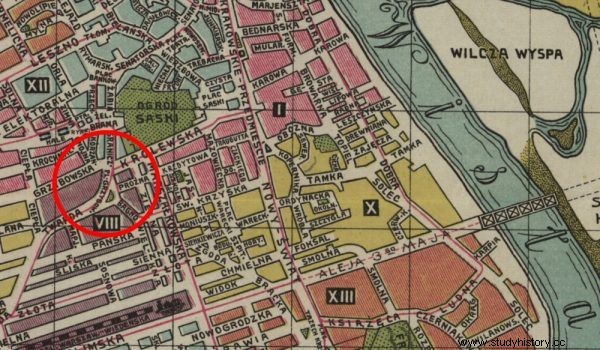
Grzybowski Square is marked on the map of Warsaw from 1904.
Around eleven o'clock, the assistant to the commissioner of District VIII enters the steps of the church and threatens the crowd that if they do not go home, they will earn 3 months in prison or 3,000 zlotys. penalty rubles. The crowd won't budge.
At half past twelve, the policemen stop trams and carriages all over Grzybowo. At quarter past twelve, the first faithful leave the church after the mass. Almost everyone in the crowd looks at their watch. Everyone is waiting for one o'clock.
On the right side of the church stairs, a group of 60 mostly armed fighters gathers. The tension is so great that the leaders of the action decide:
We're starting ahead of time!
At 12.20, Stefan Okrzei's sister takes out a small red bundle from under her blouse and hands it to the fighter "Zdun". One of the leaders of the demonstration, Nejman, then exclaims:"Cloth up!" and there is silence on the stairs as if he sowed poppy seed. Stefan Okrzeja, his sister and other fighters are standing next to "Zdun".
Everyone chants "Warszawianka". At the first words, the inexhaustible crowd that clogs the square takes off their hats. And then, over the heads of Okrzei and "Zdun", a rather small red banner with the inscription:
unfoldsPPS Down with war and tsarism! Long live the Free Polish People!
Mars under bullets and sabers
The front of the march with the banner moves towards Bagno Street. A minute later, 80 policemen, hidden there since morning, pour out of the gate at the corner of Bagno Street and Grzybowski Square. The assistant commissioner shouts the command: Szaszki won! and sabers appear in their hands.
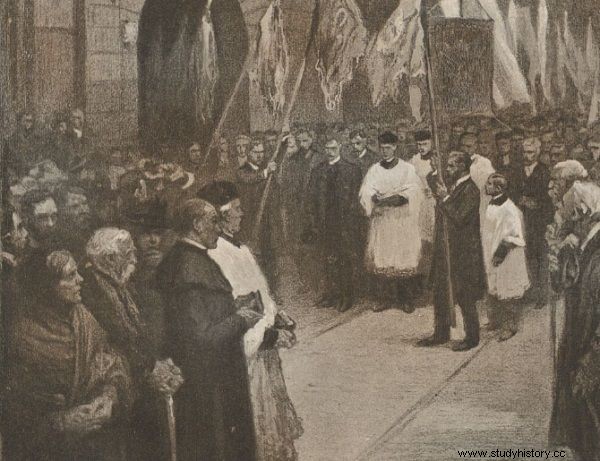
The Tsar's soldiers had no respect for the temple. They were shooting inside the church where the faithful were gathered.
The first policeman runs to "Zdun" and wants to grab the flag pole, but "Zdun" takes out a Browning and suddenly shoots the attacker in the mouth. The first corpse collapses on the pavement of the square. A moment later Okrzeja fires and a cannonade of over thirty revolvers is already roaring.
Many socialists had a priori sight of the hated policemen and now shoot only at them. Bronisław Żukowski shoots three times at the assistant to the commissioner of District VIII, but misses. Gawroński throws the bomb, but the projectile does not explode. The policemen rush back, in the commotion they kidnap some of the fighters and onlookers.
Defend the banner!
There are a dozen or so fighters around the banner. They do not pay attention to the gendarmes shooting at them from a distance, they continue along Bagno Street. In the middle of the street, they repel the charge of a dozen or so mounted gendarmes with dense shootings. One of them is crushed by a killed horse.
At Świętokrzyska, the group around the banner is trying to disperse the dragoons, but two revolver volleys drive them away.
A moment later, the Peeees hide the banner and disperse in the crowd of onlookers.
Meanwhile, the army called for help surrounds the square. Terrified onlookers and fighters scattered in the crowd flee to the church. In a crowded temple, an old priest is just paying the sum. Several police bullets rush into the church.
The faithful hide behind the benches. The priest asks from the pulpit to sing "Who takes care ...", but amidst the screams of terror from the crowd, the songs cannot be heard.
The police and the army surround the church on Grzybowski Square. Several hundred of the faithful and a group of fighters have nowhere to run.
Word oberpolicmajstra
In Bagno Street, someone from behind a fence is throwing a stone at the dragoons officer. In retaliation, the officer orders the dragons to shoot a crowd of passersby. After three volleys, there are eight dead and a dozen wounded on the pavement.
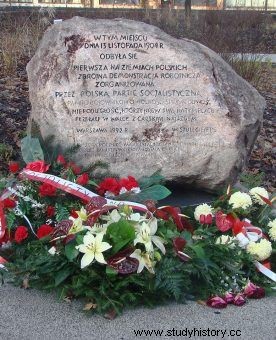
Stone in memory of the events of November 13, 1904.
At half past three, Oberpolice Major Nolken arrives at the besieged church. He urges the faithful to leave. Through the ajar gate, they answer that the police are beating the outgoing. Nolken gives his word of honor that no one will be beaten from now on.
Two hundred people are accompanied by a priest. The gendarmes lead them aside, Nolken has the church door closed so that the square cannot be seen from inside, and the policemen massacre everyone, including women, old people and children, with their butts. Then they lead the bloodied ones to the arrest.
The gendarmes take out the last batch of those who are surrounded in the church at 10.30 p.m. In total, 618 people are arrested in the town hall and in Pawiak. Then the policemen search the church. They find fourteen abandoned revolvers in it.
Until the evening the downtown streets are crowded with excited crowds. Some of the inhabitants of Warsaw denounce the desecration of the church and sacrifices among civilians, others beaming with pride - for the first time since the fall of the January Uprising, Poles are shooting at the tsarist torturers.
Source:
The article is a slightly shortened version of the chapter "The Word Oberpolicmajstra" from the latest book by Włodzimierz Kalicki entitled "It happened" (Znak 2014). The title, lead and subtitles come from the editors.
